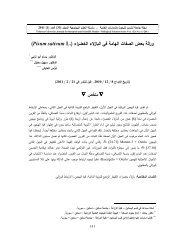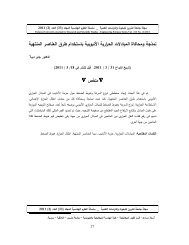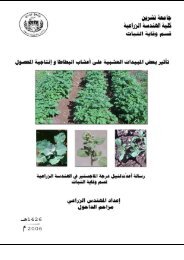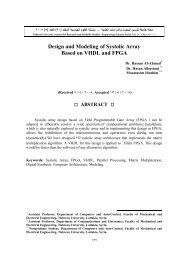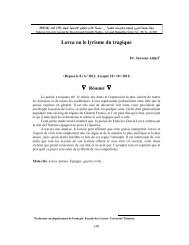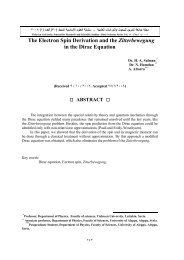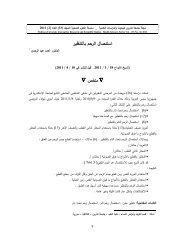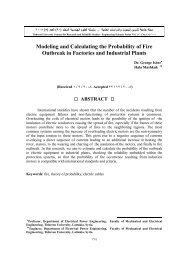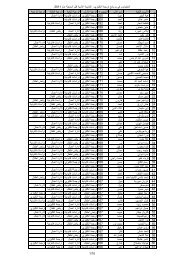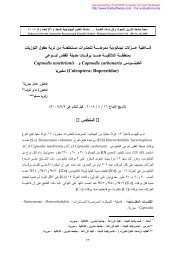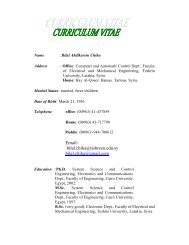- Page 3 and 4:
. منسّق:بعد: ٠٫٦
- Page 5 and 6:
محذوف: منسّق:خط ال
- Page 7 and 8:
... [28]... [29]... [30]... [31]...
- Page 9:
... [67]... [68]... [69]... [70]...
- Page 13 and 14:
منسّقمنسّق:خط اللغ
- Page 16 and 17:
منسّق:الخط: دون غا
- Page 18 and 19:
منسّق:الخط: دون غا
- Page 20 and 21:
منسّق:الخط: دون غا
- Page 22 and 23:
منسّق:الخط: دون غا
- Page 24 and 25:
منسّق:الخط: دون غا
- Page 26 and 27:
منسّق:الخط: دون غا
- Page 28 and 29:
منسّق:الخط: دون غا
- Page 30 and 31:
منسّق:الخط: دون غا
- Page 32 and 33:
منسّق:الخط: دون غا
- Page 34 and 35:
منسّق:الخط: دون غا
- Page 36 and 37:
منسّق:صفحة أولى مخت
- Page 38 and 39:
منسّق:الخط: ١٤ نقط
- Page 40 and 41:
منسّق:الخط: ١٤ نقط
- Page 42 and 43:
منسّق:الخط: ١٤ نقط
- Page 44 and 45:
منسّق:الخط: ١٤ نقط
- Page 46 and 47:
منسّق:الخط: ١٤ نقط
- Page 48 and 49:
منسّق:الخط: ١٤ نقط
- Page 50 and 51:
منسّق:الخط: ١٤ نقط
- Page 52 and 53:
منسّق:الخط: ١٤ نقط
- Page 54 and 55:
منسّق:الخط: ١٤ نقط
- Page 56 and 57:
منسّق:الخط: ١٤ نقط
- Page 58 and 59:
منسّق:الخط: ١٤ نقط
- Page 60 and 61:
منسّق:الخط: ١٤ نقط
- Page 62:
منسّق:الخط: ١٤ نقط
- Page 65 and 66:
منسّق:الخط: ١٤ نقط
- Page 67 and 68:
منسّق:الخط: ١٤ نقط
- Page 69 and 70:
منسّق:الخط: ١٤ نقط
- Page 71 and 72:
منسّق:الخط: ١٤ نقط
- Page 73 and 74:
... [206]... [207]... [208]منسّ
- Page 75 and 76:
منسّق:الخط: ١٤ نقط
- Page 77 and 78:
... [245]... [246]... [247]... [248
- Page 79 and 80:
منسّق:الخط: ١٤ نقط
- Page 81 and 82:
... [278]... [279]... [280]منسّ
- Page 83 and 84:
منسّق:الخط: ١٤ نقط
- Page 85 and 86:
منسّق:الخط: ١٤ نقط
- Page 87 and 88:
منسّق:الخط: ١٤ نقط
- Page 89 and 90:
... [330]... [331]... [332]منسّ
- Page 91 and 92:
منسّق:الخط: ١٤ نقط
- Page 93 and 94:
منسّق:الخط: ١٤ نقط
- Page 95 and 96:
منسّق:الخط: ١٤ نقط
- Page 97 and 98:
منسّق:الخط: ١٤ نقط
- Page 99 and 100:
منسّق:الخط: ١٤ نقط
- Page 101 and 102:
منسّق:الخط: ١٤ نقط
- Page 103 and 104:
منسّق:الخط: ١٤ نقط
- Page 105 and 106:
منسّق:الخط: ١٤ نقط
- Page 107 and 108:
منسّق:الخط: ١٤ نقط
- Page 109 and 110:
منسّق:الخط: ١٤ نقط
- Page 111 and 112:
منسّق:الخط: ١٤ نقط
- Page 113 and 114:
منسّق:الخط: ١٤ نقط
- Page 115 and 116:
منسّق:الخط: ١٤ نقط
- Page 117 and 118:
منسّق:الخط: ١٤ نقط
- Page 119 and 120:
منسّق:الخط: ١٤ نقط
- Page 121 and 122:
منسّق:الخط: ١٤ نقط
- Page 123 and 124:
... [445]... [446]... [447]... [448
- Page 125 and 126:
منسّق:الخط: ١٤ نقط
- Page 127 and 128:
منسّق:الخط: ١٤ نقط
- Page 129 and 130:
... [463]... [464]... [465]طور/
- Page 131 and 132:
منسّق:الخط: ١٤ نقط
- Page 133 and 134:
منسّق:الخط: ١٤ نقط
- Page 135 and 136:
منسّق:الخط: ١٤ نقط
- Page 137 and 138:
منسّق:الخط: ١٤ نقط
- Page 139 and 140:
منسّق:الخط: ١٤ نقط
- Page 141 and 142:
منسّق:الخط: ١٤ نقط
- Page 143 and 144:
منسّق:الخط: ١٤ نقط
- Page 145 and 146:
منسّق:الخط: ١٤ نقط
- Page 147 and 148:
منسّق:الخط: ١٤ نقط
- Page 149 and 150: منسّق:الخط: ١٤ نقط
- Page 151 and 152: منسّق:الخط: ١٤ نقط
- Page 153 and 154: منسّق:الخط: ١٤ نقط
- Page 155 and 156: منسّق:الخط: ١٤ نقط
- Page 157 and 158: منسّق:الخط: ١٤ نقط
- Page 159 and 160: منسّق:الخط: ١٤ نقط
- Page 161 and 162: منسّق:الخط: ١٤ نقط
- Page 163 and 164: منسّق:صفحة أولى مخت
- Page 165 and 166: منسّق:متوسط، الحد
- Page 167 and 168: منسّق:الخط: دون غا
- Page 169 and 170: منسّق:عنوان ١، الحد
- Page 171 and 172: منسّق:عنوان ١، الحد
- Page 173 and 174: منسّق:عنوان ١، الحد
- Page 175 and 176: منسّق:عنوان ١، الحد
- Page 178 and 179: منسّق:عنوان ١، الحد
- Page 180 and 181: منسّق:عنوان ١، الحد
- Page 182 and 183: منسّق:عنوان ١، الحد
- Page 184 and 185: منسّق:عنوان ١، الحد
- Page 186 and 187: منسّق:الخط: دون غا
- Page 188 and 189: منسّق:خط اللغة العر
- Page 190 and 191: ٠٩:٠٤:٠٠ ٢٠٠٨/٠٢/١٣
- Page 192 and 193: - - أبو كف:نبيلد
- Page 194 and 195: Unknownالصفحة [35] IV: تغي
- Page 196 and 197: خط اللغة العربية وغ
- Page 198 and 199: Unknownالصفحة [101] VII: تغ
- Page 202 and 203: ١٢:٥٠:٠٠ ٢٠٠٧/١٢/١٨
- Page 204 and 205: عنوان ١، المسافة ال
- Page 206 and 207: ١١:٤٤:٠٠ ٢٠٠٨/٠٢/٠٨
- Page 208 and 209: ١٠:٢٦:٠٠ ٢٠٠٨/٠١/٠١
- Page 210 and 211: ٠٫٥عادي، متوسط،
- Page 212 and 213: الخط: ١٢ نقطة،
- Page 214 and 215: ١١:٠٣:٠٠ ٢٠٠٨/٠١/٠١
- Page 216 and 217: الموضع: أفقياً:
- Page 218 and 219: ١٢:٥٨:٠٠ ٢٠٠٨/٠١/٠٤
- Page 220 and 221: ١٢:٥٨:٠٠ ٢٠٠٨/٠١/٠٤
- Page 222 and 223: ١١:٥٣:٠٠ ٢٠٠٨/٠١/٠٣
- Page 224 and 225: ١٠:٢١:٠٠ ٢٠٠٨/٠١/٠٢
- Page 226 and 227: الخط: ١٢ نقطة، د
- Page 228 and 229: ,١١:٤٦:٠٠ ٢٠٠٨/٠١/٠٢
- Page 230 and 231: ١٢:٥٠:٠٠ ٢٠٠٨/٠١/٠٢
- Page 232 and 233: . ()
- Page 234 and 235: , () Sharf and Batta
- Page 236 and 237: , ,.(Powell and Bellows, 1992)
- Page 238 and 239: ٠٨:٤٣:٠٠ ٢٠٠٧/١٢/٢٤
- Page 240 and 241: ١١:٠٣:٠٠ ٢٠٠٨/٠١/٠٤
- Page 242 and 243: خط اللغة العربية وغ
- Page 244 and 245: ١٢:٤٩:٠٠ ٢٠٠٨/٠١/٢٨
- Page 246 and 247: ١٢:٥٨:٠٠ ٢٠٠٨/٠١/٠٤
- Page 248 and 249: ٠٩:٠٤:٠٠ ٢٠٠٨/٠١/٠٢
- Page 250 and 251:
الخط: ١٢ نقطة، د
- Page 252 and 253:
١١:٢٣:٠٠ ٢٠٠٨/٠١/٠٤
- Page 254 and 255:
,١٠:٢٤:٠٠ ٢٠٠٨/٠١/٠٢
- Page 256 and 257:
٠٨:٤٩:٠٠ ٢٠٠٨/٠٢/٠٨
- Page 258 and 259:
١٢:٥٨:٠٠ ٢٠٠٨/٠١/٠٤
- Page 260 and 261:
١١:٢٨:٠٠ ٢٠٠٨/٠١/٠٤
- Page 262 and 263:
١١:٥٢:٠٠ ٢٠٠٨/٠٢/٠٨
- Page 264 and 265:
,١١:١٨:٠٠ ٢٠٠٨/٠١/٠٢
- Page 266 and 267:
,١١:٢٧:٠٠ ٢٠٠٨/٠١/٠٢
- Page 268 and 269:
١١:٣٢:٠٠ ٢٠٠٨/٠١/٠٢
- Page 270 and 271:
LSD,,,,,,,, B. tabaci .
- Page 272 and 273:
.( Carabali) .(
- Page 274 and 275:
. .
- Page 276 and 277:
Eichelkrout and -- Aza
- Page 278 and 279:
, , S..(Powell and Bellow
- Page 280 and 281:
() Sengonca . , S. p
- Page 282 and 283:
(Coleoptera: Coccinellidae) Delphas
- Page 284 and 285:
. S. parcesetosum
- Page 286 and 287:
١٠:٥٥:٠٠ ٢٠٠٨/٠١/٠٦
- Page 288 and 289:
E. eremicus () Hoddle.En. formosa
- Page 290 and 291:
% , % %,
- Page 292 and 293:
London.Abboud, R. and Ahmad, M. 199
- Page 294 and 295:
Bi, J.L., N Toscano and G.R. Ballme
- Page 296 and 297:
Davidson, E. W., F. E. Farmer and W
- Page 298 and 299:
Ellsoworth, P.C., and T.F. Watson,
- Page 300 and 301:
(Coleoptera: Coccinellidae). Enviro
- Page 302 and 303:
Johnson, M. W., N. C. Toscano, H. T
- Page 304 and 305:
Malausa, J. C., E. Franco and P. Br
- Page 306 and 307:
Ren, S. X., P. A. Stansly and T. X.
- Page 308 and 309:
Uygun, N., M.R. Ulusoy, Y. Karaca,
- Page 310 and 311:
١٢:٥٨:٠٠ ٢٠٠٨/٠١/٠٤
- Page 312 and 313:
٣٤٣٤٣٤٣٥٣٥٣٥٣٥٣٥٣
- Page 314 and 315:
٦٩٧٤٧٨٧٩٨٠٨٣٨٤٨٥٨
- Page 316 and 317:
٧٥٧٥٧٦٧٧٧٧٧٨٧٩٨٢٨
- Page 318 and 319:
١٢:٥٨:٠٠ ٢٠٠٨/٠١/٠٤
- Page 320:
١٢:٥٨:٠٠ ٢٠٠٨/٠١/٠٤



